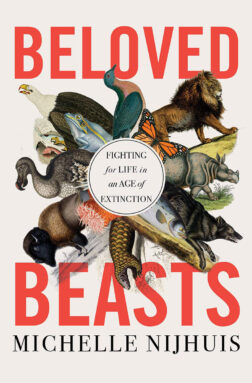This post was originally published on this site
Beloved Beasts
Michelle Nijhuis
W.W. Norton & Co., $27.95
On October 29, 1929, a date best remembered for the infamous Black Tuesday stock market crash, socialite and amateur bird watcher Rosalie Edge attended a meeting of the National Association of Audubon Societies. She was there to ask whether it was true, as a pamphlet had claimed, that the organization supported bounties on bald eagles in Alaska and turning wildlife refuges into shooting grounds.
The men who led the organization were outraged that she brought up the issue. But the pamphlet revealed a truth about conservation at the time: The movement was not as much about saving species as it was about saving only certain species that people liked. And sometimes people only liked those species because they liked to kill them.
The idea of conservation has evolved a lot over the last two centuries, as Michelle Nijhuis documents in her new book, Beloved Beasts: Fighting for Life in an Age of Extinction. It was only in the mid-1700s that Carl Linnaeus began formalizing the idea of species. The recognition that a species could actually go extinct followed soon after. The push to prevent extinctions from happening came in the 1800s, with the realization that species such as the dodo had disappeared forever. Now we know that humans are driving such losses at a rate not seen for millions of years.
Edge is just one of the many people who Nijhuis highlights in her excellent history. She includes famous names, such as Aldo Leopold, who in the early 20th century shaped the field of wildlife biology and whose writings have influenced generations, and Rachel Carson, whose 1962 book Silent Spring inspired huge changes to U.S. environmental laws and the creation of the Environmental Protection Agency. But it’s Nijhuis’ tales of lesser-known people, such as Edge and Michael Soulé, who is considered the father of conservation biology, that prove most fascinating. Their stories show how a single person can spark big changes, creating organizations and efforts that last for decades and grow to span the globe.
The book truly shines, though, when Nijhuis is brutally honest about how the conservation movement gained a reputation for being antihuman. Prominent conservationists in the 19th and 20th centuries at times endorsed abhorrent practices, such as eugenics. But more often and more subtly, the movement has advocated for actions such as removing Indigenous communities from areas set aside for wildlife.
Nijhuis also recognizes the need to move beyond worrying about saving eagles or any other single species. We must save whole ecosystems, all while balancing human needs, she writes.
One example of such a holistic approach comes from Namibia, home to iconic animals like rhinos and giraffes, where conservation is not a top-down effort guided by governments or organizations with offices on the other side of the planet. It’s carried out by dozens of local conservancies that consider the needs of both their local animals and their local people. Through detailed scrutiny, Nijhuis shows that Namibia’s model is proving successful.
Past methods of saving species, such as focusing solely on charismatic animals, won’t halt what is now recognized by many as Earth’s sixth mass extinction. But the book’s focus on paths forward provides a bit of hope. That hope springs from collective action: We all must step up to save our planet’s beloved beasts.
Buy Beloved Beasts from Bookshop.org. Science News is a Bookshop.org affiliate and will earn a commission on purchases made from links in this article.

